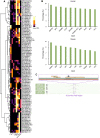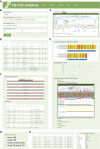TE-TSS: an integrated data resource of human and mouse transposable element (TE)-derived transcription start site (TSS)
- PMID: 37956335
- PMCID: PMC10767810
- DOI: 10.1093/nar/gkad1048
TE-TSS: an integrated data resource of human and mouse transposable element (TE)-derived transcription start site (TSS)
Abstract
Transposable elements (TEs) are abundant in the genome and serve as crucial regulatory elements. Some TEs function as epigenetically regulated promoters, and these TE-derived transcription start sites (TSSs) play a crucial role in regulating genes associated with specific functions, such as cancer and embryogenesis. However, the lack of an accessible database that systematically gathers TE-derived TSS data is a current research gap. To address this, we established TE-TSS, an integrated data resource of human and mouse TE-derived TSSs (http://xozhanglab.com/TETSS). TE-TSS has compiled 2681 RNA sequencing datasets, spanning various tissues, cell lines and developmental stages. From these, we identified 5768 human TE-derived TSSs and 2797 mouse TE-derived TSSs, with 47% and 38% being experimentally validated, respectively. TE-TSS enables comprehensive exploration of TSS usage in diverse samples, providing insights into tissue-specific gene expression patterns and transcriptional regulatory elements. Furthermore, TE-TSS compares TE-derived TSS regions across 15 mammalian species, enhancing our understanding of their evolutionary and functional aspects. The establishment of TE-TSS facilitates further investigations into the roles of TEs in shaping the transcriptomic landscape and offers valuable resources for comprehending their involvement in diverse biological processes.
© The Author(s) 2023. Published by Oxford University Press on behalf of Nucleic Acids Research.
Figures







Similar articles
-
Transposable Element Exaptation into Regulatory Regions Is Rare, Influenced by Evolutionary Age, and Subject to Pleiotropic Constraints.Mol Biol Evol. 2017 Nov 1;34(11):2856-2869. doi: 10.1093/molbev/msx219. Mol Biol Evol. 2017. PMID: 28961735 Free PMC article.
-
Epigenetic regulation of transposable element derived human gene promoters.Gene. 2011 Apr 1;475(1):39-48. doi: 10.1016/j.gene.2010.12.010. Epub 2011 Jan 6. Gene. 2011. PMID: 21215797
-
Epigenomic analysis reveals prevalent contribution of transposable elements to cis-regulatory elements, tissue-specific expression, and alternative promoters in zebrafish.Genome Res. 2022 Jul;32(7):1424-1436. doi: 10.1101/gr.276052.121. Epub 2022 Jun 1. Genome Res. 2022. PMID: 35649578 Free PMC article.
-
Transposable elements in mammalian chromatin organization.Nat Rev Genet. 2023 Oct;24(10):712-723. doi: 10.1038/s41576-023-00609-6. Epub 2023 Jun 7. Nat Rev Genet. 2023. PMID: 37286742 Review.
-
Exaptation of transposable elements into novel cis-regulatory elements: is the evidence always strong?Mol Biol Evol. 2013 Jun;30(6):1239-51. doi: 10.1093/molbev/mst045. Epub 2013 Mar 13. Mol Biol Evol. 2013. PMID: 23486611 Free PMC article. Review.
References
MeSH terms
Substances
Grants and funding
LinkOut - more resources
Full Text Sources
Miscellaneous

